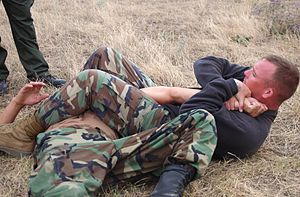Armbar
| Armlock | |
|---|---|

Armlock shown is a straight arm bar (jūji-gatame)
|
|
| Classification | Joint-lock |
| Parent hold | Various Grappling positions |
| Child hold(s) | Wristlock |
An armlock in grappling is a single or double joint lock that hyperextends, hyperflexes or hyperrotates the elbow joint or shoulder joint. An armlock that hyperflexes or hyperrotates the shoulder joint is referred to as a shoulder lock, and an armlock that hyperextends the elbow joint is called an armbar. Depending on the joint flexibility of a person, armlocks that hyperrotate the shoulder joint can also hyperrotate the elbow joint, and vice versa.
Obtaining an armlock requires effective use of full-body leverage in order to initiate and secure a lock on the targeted arm, while preventing the opponent from escaping the lock. Therefore, performing an armlock is less problematic on the ground, from positions such as the mount, side control, or guard. Armlocks are more difficult to perform when both combatants are standing up, though the stand-up variants are a focus in certain systems such as Chin Na. Furthermore, a failed armlock can sometimes result in the opponent escaping and obtaining a dominant position.
Armlocks, considered less dangerous techniques in combat sports allowing joint locks, are the most common joint locks used as submission holds. In training, the method of executing an armlock is generally slow and controlled to give the opponent time to submit prior to any infliction of injury. However, in self-defense applications, or when applied improperly or with excessive force, armlocks can cause muscle, tendon and ligament damage, even dislocation, or bone fractures.
...
Wikipedia
